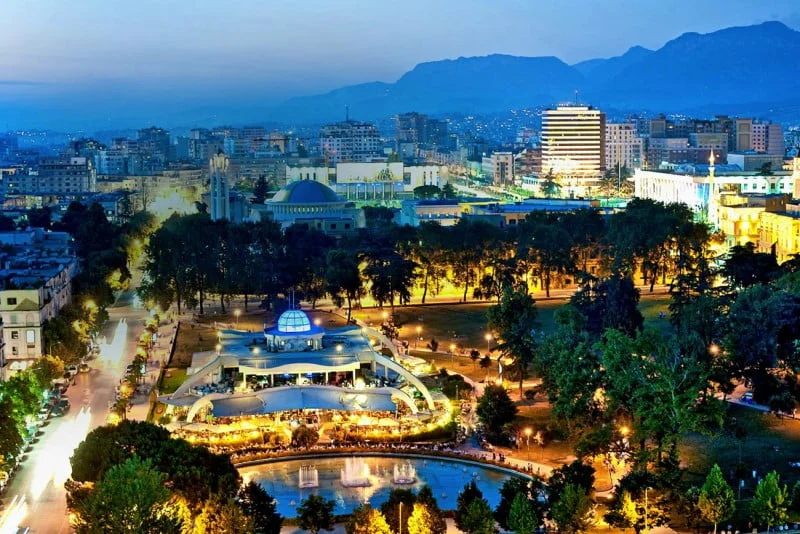Origin of the name
Although it is a new city and a modern capital, Tirana’s origin as a residential center is quite ancient with several theories and myths accompanying its current name. One version is that its name comes from the word “Theranda” in ancient Greek and Latin sources, which the locals called “Te ranat”, used by the inhabitants, which means “fallen material”, in connection with the composition of the soil from the hard ground and low, rich in water that flows from the nearby mountains. Another theory is that it derives from the word “Tirkan”, a name used by the 6th century Byzantine historian Procopius to refer to a castle, first built in the 1st century AD, on Mount Dajt, of which the ruins are preserved. Some make it derive from “Tyros”, an ancient Greek word for “dairy”, hypothesizing that it was a land where the shepherds of the surrounding areas met to trade milk products.
Foundation of the city (Ottoman influence)
The city was founded by Sulejman Pasha Bargjini, a local ruler of Mullei (an area a few kilometers from the city), who built a mosque, an oven and a hamam (Turkish sauna). The city began to grow in the early 18th century, but continued to be a city of no particular importance until it was declared the capital of Albania in 1920. This was mainly due to its geographical location, more or less in the center of the country . , from the northern side between the Gegs (northern province) and the Tosks (southern province) to the south. It wasn’t until the late 1920s that the Italian influence became quite strong and the city center took on the look of a capital city.
The Monarchy
On 8 February 1920 the Congress of Lushnja declared Tirana the temporary capital of Albania, which had obtained independence in 1912. In 1923 the first master plan of the city was drawn up by Austrian architects. So the construction in the center of Tirana was part of the cooperation package between Zog, the king of Albania and fascist Italy. Ahmet Zogu was the leader of Albania from 1922 to 1939. He served first as Prime Minister (1922-1924), then as President (1925-1928) and finally as King (1928-1939). The center of Tirana is the project of Florestano di Fausto and Armando Brasini, well-known architects of the Benito Mussolini period in Italy. Brasini laid the foundations for the modernization and arrangement of the ministerial buildings in the city centre. The project was reviewed by the Albanian architect Eshref Frashëri, the Italian architect Castellani and the Austrian architects Weiss and Kohler. The modern Albanian parliamentary building served as an officers’ club. At that time, in September 1928, Zog of Albania was crowned King Zog I, King of the Albanians.
Italian architecture
Famous architects of the Mussolini period in Italy, Florestano de Fausto and Armando Brasini, were the masters who created the main square, which today bears the name of the National Hero Gjergj Kastrioti Skënderbeu, the large avenue, the buildings of the ministries, the national bank, the town hall and the Palazzo delle Brigate (former royal palace, now the Presidential Palace). In 1939 Tirana was occupied by fascist forces and a puppet government was appointed. Meanwhile, Italian architect Gherardo Bosio was asked to refine previous plans and present a new project in today’s Piazza Madre Teresa area. In the early 1940s, the southern part of the main avenue and the surrounding buildings were finished and renamed with fascist names.
Communist style
From 1944 to 1991, the city experienced a decline in architectural quality. Huge socialist-style apartment complexes began to be built, while Skënderbej Square was rebuilt with several buildings that had been destroyed. For example, the former Old Bazaar of Tirana and the Orthodox Cathedral were razed for the construction of the Soviet palace called the Palace of Culture. The complex of buildings of the municipality built in the Italian style was demolished and in their place the National Historical Museum was built, while the structure that served the Parliament of Albania, during the monarchy, was transformed into a children’s theater (today Teatro dei Pupazzi ) The northern part of the main avenue was renamed Stalin Boulevard, and his statue was erected in the city square. Private property and motoring were banned, mass transit mainly consisting of bicycles, trucks and buses. After the death of dictator Enver Hoxha, the government built a pyramid museum in his memory. This building is known as the Pyramid but now it has nothing to do with Enver Hoxha as it has become the Cultural Center of Tirana.
Modern Tirana
Today Tirana is the center of political, economic and cultural life of the country, with about 1,000,000 inhabitants. In recent years, Tirana has undergone substantial changes in its appearance. The communist-era apartments were painted in bright colors and abstract patterns by an artist who was the mayor of the municipality (Mr. Edi Rama). This has not only been a solution but also an inspiration for the residents and visitors as well. Furthermore, Tirana has undergone an ever increasing development in modern infrastructure, contributing to the city’s metropolitan feel. Tirana changes every day. Skenderbej Square has recently been restored, the inauguration of which took place on 10 June 2017. In recent years, Tirana has become a destination of interest to be visited by foreign tourists. Most of the tourists who come to visit Tirana are Europeans, who see it as a budget destination that has a lot to offer. In 2022 Tirana was crowned with the title of “European Capital of Youth”, while for 2023 it was crowned with the title of “European Capital of Sport”.


